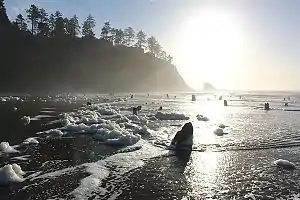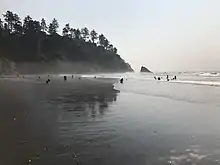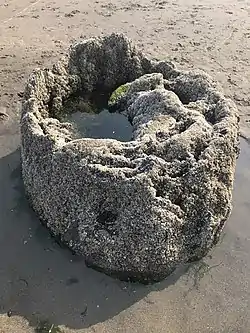Neskowin Ghost Forest
The Neskowin Ghost Forest is the remnants of a Sitka spruce forest on the Oregon Coast of the United States. The stumps were likely created when an earthquake of the Cascadia subduction zone abruptly lowered the trees, that were then covered by mud from landslides or debris from a tsunami.[1] Many of the stumps are over 2,000 years old.[2]

The stumps were unearthed when turbulent storms swept away sand during the winter of 1997–1998.[3][4] It is one of over thirty ghost forests along the Oregon and Washington Coast, though many appear as flat roots and not stumps.[5] Most notably, Washington's ghost forest of red cedars was integral to the discovery of the Cascadia fault line.[6] These ghost forests are evidence of significant, rapid changes in coastline – often due to seismic events such as the 1700 Cascadia earthquake.[7]
The stumps at Neskowin are 2,000 years old, according to carbon dating.[8] While living, the trees that make up the Neskowin Ghost Forest were similar to present-day coastal rain forest.[8] They stood 150–200 feet (46–61 m) high[3] and were at least 200 years old when buried.[9] However, it's difficult to determine when or how the trees died, because it occurred before written history in the region. It was originally believed that these trees died slowly, as the roots were gradually submerged in saltwater due to changes in the sea levels. Yet research by geologists revealed that the soil, still present at the roots of the stumps, was buried abruptly[8] – indicating a more sudden and dramatic event, like an earthquake, as the cause.
The ghost forest is near Proposal Rock. It is part of the Neskowin Beach State Recreation Site.[10] The best time to see the stumps is low tide, during winter (due to January, February and March bringing the lowest tides of the year.)[11]
 Stumps of trees at the Neskowin Ghost Forest
Stumps of trees at the Neskowin Ghost Forest Neskowin Ghost Forest in August 2017
Neskowin Ghost Forest in August 2017 Large tree stump protruding from beach sand
Large tree stump protruding from beach sand Tree Stumps visible with Proposal Rock in background.
Tree Stumps visible with Proposal Rock in background.
References
- Fish, Peter. "The ghost forest". Sunset. Retrieved 13 December 2016.
- "OSU research of ancient stumps should continue despite criticism". LIFE@OSU. 12 November 2008. Retrieved 13 December 2016.
- Bettey, Sarah. "Neskowin ghost forest". Travel Oregon. Retrieved 13 December 2016.
- Cain, Brad (5 April 1998). "El Nino reveals traces of ancient forest in Oregon surf". Los Angeles Times. Retrieved 13 December 2016.
- "In search of more Oregon coast ghost forests". BeachConnections.net. Retrieved 13 December 2016.
- Schulz, Kathryn (20 July 2015). "The really big one". The New Yorker. Retrieved 13 December 2016.
- Spitz, Tullan. "How scientists know when the last big earthquake happened here". OPB: Oregon Public Broadcasting. Retrieved 13 December 2016.
- Hart, Roger; Peterson, Curt (1997). "Episodically buried forests in the Oregon surf zone" (PDF). Oregon Geology. 59 (6): 131–144. Retrieved 12 December 2016.
- "Twin Oregon coast secret attractions 4,000 years in the making". www.beachconnection.net. Retrieved 13 December 2016.
- "Neskowin Beach state recreation site". oregonstateparks.org. Oregon State Parks and Recreation. Retrieved 13 December 2016.
- Neal, Leanne. "Winter low tides reveal Neskowin Ghost Forest". Tillamook Coast. Retrieved 12 December 2016.